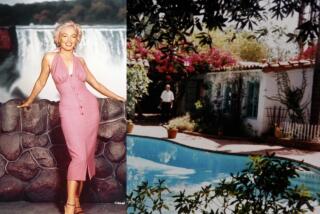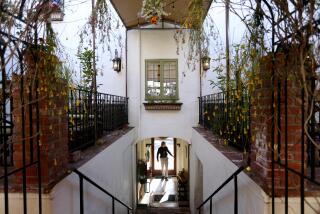S. F. Springs Plans Future of Clarke Site
SANTA FE SPRINGS — Shielded for decades from surrounding development, the historic Mary Rankin Clarke Estate south of the Civic Center is now city property and the city has begun making plans for its use.
Only the two acres immediately surrounding the house have been targeted by city staff for preservation. The rest of the six-acre estate, named after one of the original owners, is being recommended for development to help pay for the estimated $142,000-a-year maintenance costs.
Most of the lush landscape that keeps the house hidden from view may give way to two office buildings, which would occupy three acres in the south part of the estate. In the north part, another office building and additional city hall parking are planned.
Development in the south end of the estate would require the city to move the Community Gardens for do-it-yourself gardeners because it would block a new entrance to the estate on Pioneer Boulevard.
Market Study Ordered
Escrow on the property, which was purchased for $2 million, closed last week and the City Council, acting as the Redevelopment Agency, ordered city staff to begin a market study of the house as a conference and cultural center and prepare a plan to furnish it.
The staff recommended renting out the house for company retreats, seminars and even small wedding receptions, said Bob Orpin, assistant director of redevelopment and housing. A museum, an art gallery and a historical library were also recommended for the cultural center, he said.
Mayor Betty Wilson said the council would consider only those ideas that would allow preservation of the historic house and at the same time bring in revenue to offset the cost of maintenance.
Recommendations to use the house as a bed-and-breakfast inn, a restaurant and a location for television and movie productions would attract too many people and are not being seriously considered, she said.
The council has not taken action on any of the development recommendations except to reject a proposal to build a child-care center in the north end of the estate and order further studies, Wilson said.
The house, which was built in 1921, was one of the last residential projects designed by renowned architect Irving Gill, who was famous for his Spartan style using cubes, arches and concrete walls.
Jim Siemon, 82, the former owner of the estate, originally owned 11 acres, but in 1952 sold five acres, where the Civic Center now stands.
The estate is surrounded by trees and plants that, according to one city groundskeeper, give it a “sense of being 50 to 60 miles away from everything.”
Orpin said he hopes enough of the landscaping is preserved so that the house can retain its image as a “serene setting in a turbulent environment.”
More to Read
Sign up for Essential California
The most important California stories and recommendations in your inbox every morning.
You may occasionally receive promotional content from the Los Angeles Times.






